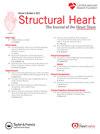经导管三尖瓣临床试验:不完整数据和 FDA 批准的设备
IF 1.4
Q3 CARDIAC & CARDIOVASCULAR SYSTEMS
引用次数: 0
摘要
每项经导管三尖瓣介入治疗试验均显示,堪萨斯城心肌病问卷(KCCQ)定义的生活质量和右心室重塑均得到了有临床意义的改善。KCCQ 与三尖瓣反流 (TR) 减少、心衰住院率和死亡率相关。因此,KCCQ 的变化既可以作为生活质量的衡量标准,也可以作为电视干预效果的替代终点。TRILUMINATE 是首个评估三尖瓣边缘对边缘修复术安全性和有效性的随机试验,该试验证明了 KCCQ 评分和良好的右心室重塑具有重要的临床意义,而这正是此类无症状人群的适当终点。TRISCEND II 评估了 EVOQUE 瓣膜的安全性和有效性,与 TRILUMINATE 相比,TRISCEND II 纳入了更多纽约心脏协会 III 级和 IV 级心衰患者,KCCQ 评分也更低。在TRISCEND II中,94%的患者接受EVOQUE三尖瓣置换术后TR降至轻度或轻度以下,而在TRILUMINATE中接受TriClip治疗的患者仅为50%。TRISCEND II 的患者风险较高,而 EVOQUE 几乎消除了 TR,这与 EVOQUE 死亡率的良好趋势是一致的。左心室收缩功能减退的患者在考虑接受上述任何一种三尖瓣介入治疗时,都应在指南指导下进行优化的药物治疗。应治疗严重的左侧瓣膜疾病。患者应进行最佳的利尿治疗,并排除严重的肺动脉高压。有持续性严重TR和症状或右心室扩大的患者应考虑进行介入治疗。较小的瓣膜瓣合间隙如果没有明显的起搏器撞击,经导管三尖瓣边缘对边缘修补术可能效果较好;而较大的瓣膜瓣合间隙和被右心室导联固定的瓣叶,尤其是可以耐受口服抗凝药的患者,经导管三尖瓣置换术可能效果最佳。本文章由计算机程序翻译,如有差异,请以英文原文为准。
Transcatheter Tricuspid Valve Clinical Trials: Incomplete Data and FDA-Approved Devices
Each reviewed trial of transcatheter tricuspid valve intervention demonstrated clinically meaningful improvement in Kansas City Cardiomyopathy Questionnaire (KCCQ)-defined quality of life and favorable right ventricular remodeling. KCCQ correlates with tricuspid regurgitation (TR) reduction, heart failure hospitalization, and mortality. Change in KCCQ is therefore meaningful both as a measure of quality of life and as a surrogate endpoint of the impact of TV interventions. TRILUMINATE, the first randomized trial to evaluate the safety and efficacy of tricuspid edge-to-edge repair, demonstrated clinically important benefits in KCCQ score and favorable right ventricular remodeling, which are appropriate endpoints for this symptomatic population. TRISCEND II, which evaluated the safety and effectiveness of the EVOQUE valve, enrolled patients with more New York Heart Association class III and IV heart failure and lower KCCQ scores than TRILUMINATE. EVOQUE tricuspid valve replacement in TRISCEND II reduced TR to mild or less in 94% of patients compared to 50% of patients treated with TriClip in TRILUMINATE. The higher-risk TRISCEND II population and the near elimination of TR with EVOQUE are consistent with the favorable trend in EVOQUE mortality. Patients with diminished left ventricular systolic function being considered for either of these tricuspid valve interventions should be optimized with guideline directed medical therapy. Significant left-side valve disease should be treated. Patients should be optimally diuresed and excluded with severe pulmonary hypertension. Patients with persistent severe TR and symptoms or right ventricular enlargement should be considered for intervention. Smaller coaptation gaps without significant pacemaker impingement may be well served with transcatheter tricuspid edge-to-edge repair, while larger coaptation gaps and leaflets pinned by right ventricular leads, particularly in patients tolerating oral anticoagulation, may be best served with transcatheter tricuspid valve replacement.
求助全文
通过发布文献求助,成功后即可免费获取论文全文。
去求助
来源期刊

Structural Heart
Medicine-Cardiology and Cardiovascular Medicine
CiteScore
1.60
自引率
0.00%
发文量
81
 求助内容:
求助内容: 应助结果提醒方式:
应助结果提醒方式:


